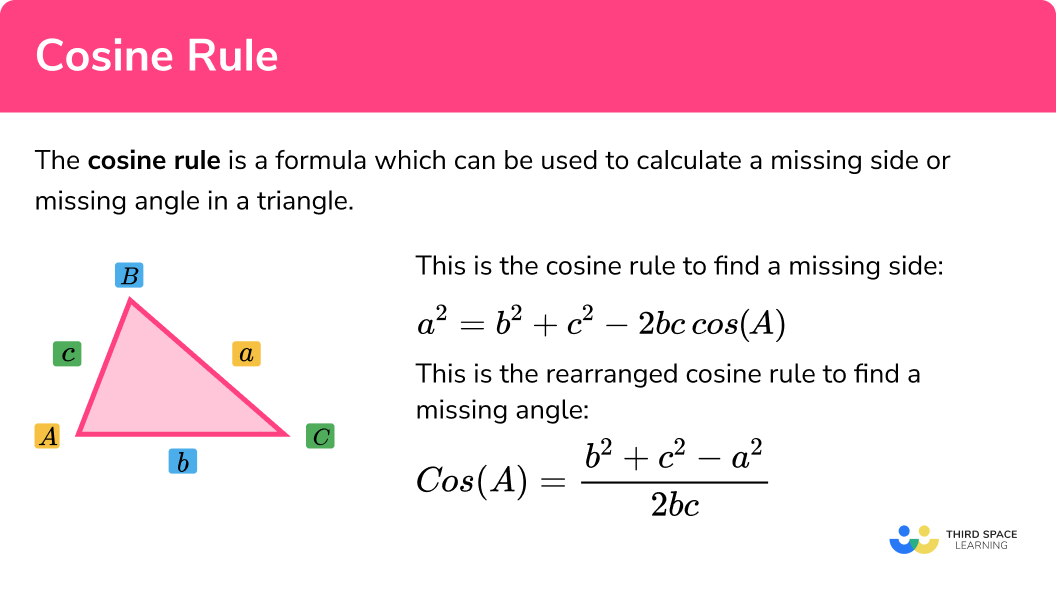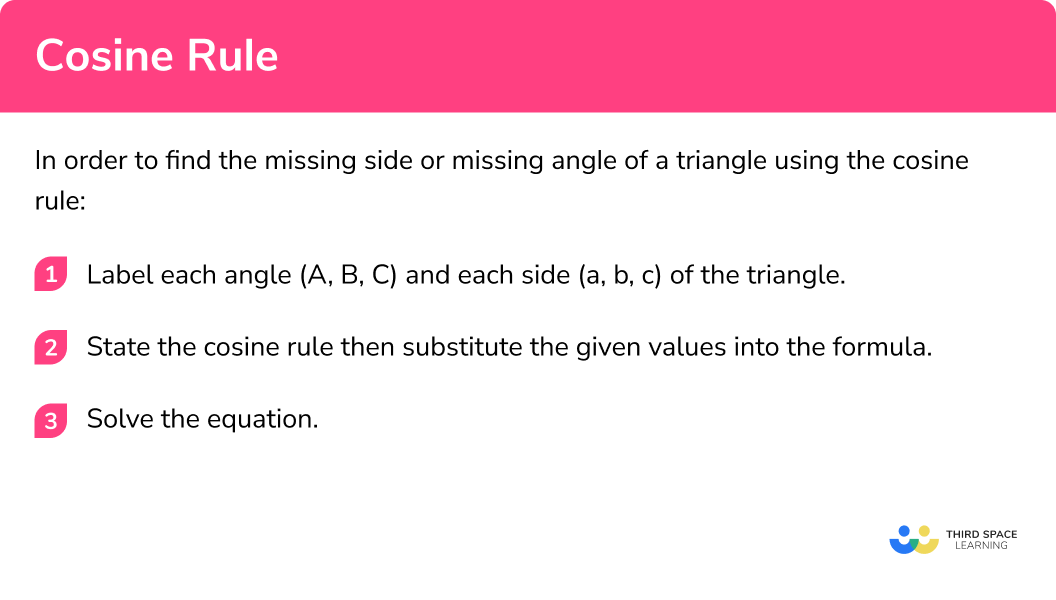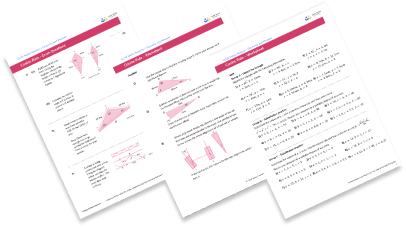GCSE Tutoring Programme
Our chosen students improved 1.19 of a grade on average - 0.45 more than those who didn't have the tutoring.
In order to access this I need to be confident with:
Trigonometric functions Solving equations Rearranging equations Rounding numbers Significant figures Exact trig values SOHCAHTOA Sine ruleThis topic is relevant for:

Cosine Rule
Here we will learn about the cosine rule including how to use the cosine rule to find missing sides and angles in a non right-angled triangles and when to use the cosine rule instead of using the sine rule, Pythagoras’ Theorem or SOHCAHTOA.
There are also cosine rule worksheets based on Edexcel, AQA and OCR exam questions, along with further guidance on where to go next if you’re still stuck.
What is the cosine rule?
The cosine rule (or the law of cosines) is a formula which can be used to calculate the missing sides of a triangle or to find a missing angle. To do this, we need to know the two arrangements of the formula and what each variable represents.
Take a look at the triangle
This triangle has exactly the same set up as the sine rule, with the sides represented by lower case letters and the opposite angles represented by the same capitalised letters, e.g. side
This is the cosine rule formula:
What is cosine rule

How can I use the cosine rule?
You can use the cosine rule to find missing sides and missing angles in triangles.
- Label each angle
(A, B, C) and each side(a, b, c) of the triangle.
In order to use the cosine rule we need to consider the angle that lies between two known sides.
Take a look at the diagram,
Here, the angle at
We always label the angle we are going to be using as
2State the cosine rule then substitute the given values into the formula.
Now that we know which sides and angles we have, we need to substitute this information into the cosine rule.
We can then solve this equation to find the missing side or angle.
As these are calculated slightly differently, we can rearrange the cosine rule to suit what we are trying to find.
Here are the two versions:
To find a missing side:
\\a^{2}=b^{2}+c^{2}-2bc\cos(A)\\
To find a missing angle:
\cos(A)=\frac{b^2+c^2-a^2}{2bc}
One equation is a rearrangement of the other.
3Solve the equation.
Once everything is substituted into the cosine rule we can solve the equation to calculate the unknown side or angle.
Also, there are some online cosine rule calculators that can help you solve several triangular problems.
See also: Trigonometry formula
When to use the cosine rule
The cosine rule is used to find a missing side or angle in a triangle when you’re given either:
- Three sides
or - Two sides and the included angle
In contrast, the sine rule is used when you are given either two angles and one side, or two sides and a non-included angle.
How to find the missing side or angle of a triangle using the cosine rule
In order to find the missing side or angle of a triangle using the cosine rule:
- Label each angle
(A, B, C) and each side(a, b, c) of the triangle. - State the cosine rule then substitute the given values into the formula.
- Solve the equation.
Explain how to find the missing side or angle of a triangle using the cosine rule


Cosine rule worksheet

Get your free cosine rule worksheet of 20+ questions and answers. Includes reasoning and applied questions.
DOWNLOAD FREE
Cosine rule worksheet

Get your free cosine rule worksheet of 20+ questions and answers. Includes reasoning and applied questions.
DOWNLOAD FREECosine rule examples (missing side)
Example 1: find the missing side using the cosine rule
Find the value of
- Label each angle
(A, B, C) and each side(a, b, c) of the triangle.
The vertices are already labelled with
2State the cosine rule then substitute the given values into the formula.
Here, we need to find the missing side
3Solve the equation.
First we need to simplify the right hand side of the equation, and then square root the solution to find the value for
Example 2: find the missing side using the cosine rule
Find the length of
Label each angle (A, B, C) and each side (a, b, c) of the triangle.
Here, it is important for us to label the angle that we need to use first. For this question, we need to find the side with length
We need to label the angle
The other two vertices are then labelled as
State the cosine rule then substitute the given values into the formula.
Here, we need to find the missing side
Solve the equation.
Example 3: find the missing side using the cosine rule
Find the length of
Label each angle (A, B, C) and each side (a, b, c) of the triangle.
In order to find the length of
We can then label vertex
State the cosine rule then substitute the given values into the formula.
Here, we need to find the missing side
Solve the equation.
Cosine rule examples (missing angle)
Example 4: find the missing angle using the cosine rule
Find the size of the angle
Label each angle (A, B, C) and each side (a, b, c) of the triangle.
Here, the vertices are already labelled, and the angle we need to find is already
State the cosine rule then substitute the given values into the formula.
Here, we need to find the missing angle
Solve the equation.
Example 5: find the missing angle using the cosine rule
Find the size of the angle
Label each angle (A, B, C) and each side (a, b, c) of the triangle.
Here, we need to label each vertex and angle. As we need to know the angle at
State the cosine rule then substitute the given values into the formula.
Here, we need to find the missing angle
Solve the equation.
Example 6: find the missing obtuse angle using the cosine rule
Find the size of the angle
Label each angle (A, B, C) and each side (a, b, c) of the triangle.
Here, we need to label each vertex and angle. As we need to know the angle at
State the cosine rule then substitute the given values into the formula.
Here, we need to find the missing angle
Solve the equation.
Common misconceptions
- Pythagoras’ Theorem and trigonometry
A common error is to use Pythagoras’ Theorem instead of trigonometry to find the missing side of the non right angle triangle
- Sine function instead of cosine function
A common error is to use the sine function instead of cosine function
See also: Sin Cos Tan
- Incorrect labelling of the vertices and sides
- Incorrectly using the cosine rule as
a2 = b2 + c2 + 2bcCos(A)
Here,
- Substituting errors
A common error is to incorrectly substitute into the cosine rule using the side length
- Substituting values into the cosine rule without the correct application of
BIDMAS
It is important to follow the order of operations when evaluating the cosine rule.
- Is there an ambiguous case for the cosine rule like there is for the sine rule?
The simple answer is no because of the nature of the cosine function and the link to finding an angle inside a triangle. E.g.
If you take
The sum of angles in a triangle must add to
Related lessons
Cosine rule is part of our series of lessons to support revision on trigonometry. You may find it helpful to start with the main trigonometry lesson for a summary of what to expect, or use the step by step guides below for further detail on individual topics. Other lessons in this series include:
Practice cosine rule questions
1. Use the cosine rule to find the length of x for triangle ABC . Give your answer to 1decimal place.




Label the triangle:
\begin{aligned} a^{2}&=b^{2}+c^{2}-2bc \cos(A)\\\\ x^{2}&=12^{2}+8^{2}-2 \times 12 \times 8 \times \cos(97)\\\\ x^{2}&=208-192 \cos(97)\\\\ x^{2}&=231.3989139\\\\ x&=\sqrt{231.3989139}\\\\ x&=15.2 ~(1\mathrm{dp}) \end{aligned}
2. Find the length of x for triangle PQR . Give your answer to 1 decimal place.




Label the triangle:
\begin{aligned} a^{2}&=b^{2}+c^{2}-2bc \cos(A)\\\\ x^{2}&=6.3^{2}+5.4^{2}-2 \times 6.3 \times 5.4 \times \cos(59)\\\\ x^{2}&=68.85-68.04\cos(59)\\\\ x^{2}&=33.80680938 \\\\ x&=\sqrt{33.80680938}\\\\ x&=5.8 ~(1\mathrm{dp}) \end{aligned}
3. Find the length of XY for triangle XYZ . Write your answer to 1 decimal place.




Label the triangle:
\begin{aligned} a^{2}&=b^{2}+c^{2}-2bc \cos(A)\\\\ x^{2}&=6^{2}+6^{2}-2 \times 6 \times 6 \times \cos(122)\\\\ x^{2}&=72-72 \cos(122)\\\\ x^{2}&=110.154187\\\\ x&=\sqrt{110.145187}\\\\ x&=10.5 ~(1\mathrm{dp}) \end{aligned}
4. Find the size of angle \theta for triangle ABC . Give your answer to 3 significant figures.




Label the triangle:
\begin{aligned} \cos(A) &= \frac{b^{2}+c^{2}-a^{2}}{2bc}\\\\ \cos(\theta)&=\frac{5.2^{2}+7.8^{2}-12^{2}}{2 \times 5.2 \times 7.8}\\\\ \cos(\theta)&= -0.6918145957\\\\ \theta&=\cos^{-1}(-0.6918145957)\\\\ \theta&=134^{\circ} \end{aligned}
5. Find the size of angle \theta for triangle XYZ . Give your answer to 3 significant figures.




Label the triangle:
\begin{aligned} \cos(A) &= \frac{b^{2}+c^{2}-a^{2}}{2bc}\\\\ \cos(\theta)&=\frac{15.1^{2}+9.8^{2}-8.3^{2}}{2 \times 15.1 \times 9.8}\\\\ \cos(\theta)&= 0.8621435329\\\\ \theta&=\cos^{-1}(0.8621435329)\\\\ \theta&=30.4^{\circ} \end{aligned}
6. Find the size of angle \theta for triangle EFG . Write your answer to 2 decimal places.




Label the triangle:
\begin{aligned} \cos(A) &= \frac{b^{2}+c^{2}-a^{2}}{2bc}\\\\ \cos(\theta)&=\frac{25^{2}+25^{2}-7^{2}}{2 \times 25 \times 25}\\\\ \cos(\theta)&= 0.9608\\\\ \theta&=\cos^{-1}(0.9608)\\\\ \theta&=16.10^{\circ} \end{aligned}
Cosine rule GCSE exam questions
1. In triangle ABC, AB = 4.5mm, AC = 8.3mm and BC = 6.1mm.
Work out the size of the angle BAC .
Give your answer to 3 sf.
(3 marks)
(1)
\begin{aligned} \cos(A)&=\frac{51.93}{74.7}\\\\ \cos(A)&=0.695… \end{aligned}
(1)
\begin{aligned} A&=\cos^{-1}(0.695…)\\\\ A&=46.0^{\circ} \end{aligned}
(1)
2. The quadrilateral ABCD is made from two triangles.
Find the length AD.
(5 marks)
(1)
\begin{aligned} BD&=76 \times \tan(44)\\\\ BD&=73.39 \mathrm{cm} \end{aligned}
(1)
(AD)^{2}=63^{2}+73.39^{2}-2 \times 63 \times 73.39 \times \cos(79)
(1)
\begin{aligned} (AD)^{2}&=9355.0921-9247.14\cos(79)\\\\ (AD)^{2}&=7590.655 \end{aligned}
(1)
AD = 87.12cm
(1)
3. A satellite takes measurements to some triangulation stations.
Calculate the distance between the triangulation stations.
(3 marks)
(1)
\begin{aligned} a^{2}&=93310-92460 \times \cos(4)\\\\ a^{2}&=1066.228 \end{aligned}
(1)
\begin{aligned} a&=\sqrt{1066.228}\\\\ a&=32.7\mathrm{km} \end{aligned}
(1)
Did you know?
The cosine rule is derived from the use of Pythagoras’ theorem
To do this, the triangle is split into two right-angled triangles. We can then use Pythagoras’ theorem to work out
Note: You are not required to know how to derive the cosine rule, however the derivation only requires knowledge of the GCSE curriculum, similar to the derivation of the quadratic formula.
Learning checklist
You have now learned how to:
-
know and apply the cosine rule to find unknown lengths and angles
The next lessons are
Still stuck?
Prepare your KS4 students for maths GCSEs success with Third Space Learning. Weekly online one to one GCSE maths revision lessons delivered by expert maths tutors.

Find out more about our GCSE maths tuition programme.